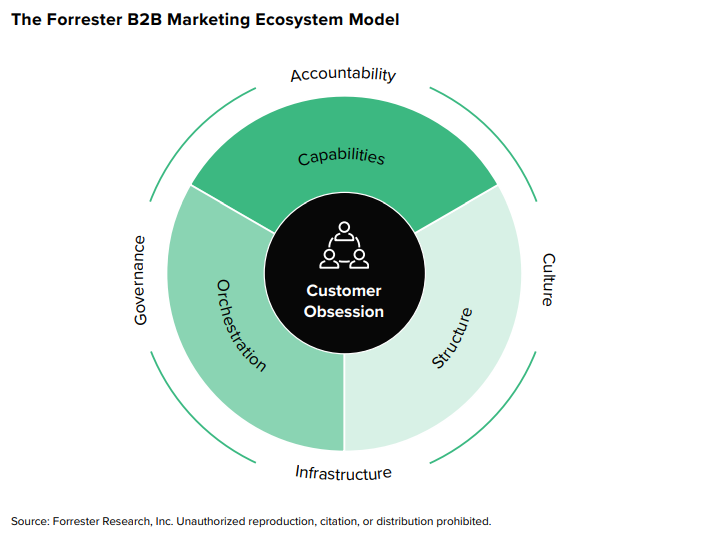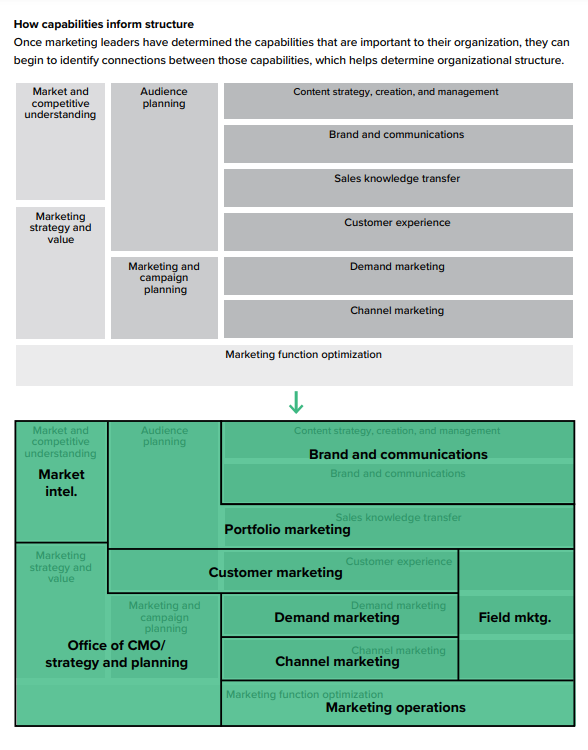Close B2B Marketing Performance Gaps | Forrester
Customer Experiences
The Quest For Optimal Marketing Performance
B2B marketing organizations serve as vital drivers of growth and customer retention. Realizing their full potential extends beyond establishing the right organizational structure; it involves cultivating a high-performance marketing ecosystem inclusive of capabilities, workflows, and the operational environment.
In this concise guide, we delve into the components of exceptional marketing performance and introduce the Forrester B2B Marketing Ecosystem Model. This model delineates the interconnectedness and interactions of these elements. Gaining insight into your distinct ecosystem empowers you to make informed decisions, fortify any vulnerabilities, and steer clear of potential pitfalls.
The Customer: The Marketing Ecosystem’s Energy Source
At the heart of every thriving ecosystem lies a pivotal energy source. In high-functioning B2B marketing organizations, this driving force is a profound understanding of the customer. Achieving superiority in the B2B landscape hinges on placing the customer at the core of the company’s entire operational framework, ensuring that all functions harmonize to provide unparalleled customer experiences.
In this context, B2B marketing leaders assume a pivotal role in fostering a culture centered around the customer and championing cross-functional alignment focused on customer value. Their mandate involves transitioning from merely accumulating buyer insights to actively activating them.
This entails embracing and promoting simple yet impactful behaviors like proactively seeking opportunities for customer interactions, adopting a customer-centric perspective in marketing efforts (e.g., entering the prospect email nurture stream), and consistently integrating customer feedback into product development.

The Inner Ring: How Marketing Supports Business Objectives
At the core of every flourishing ecosystem resides a vital energy force. In high-performing B2B marketing organizations, this driving force is a deep comprehension of the customer. Attaining excellence in the B2B landscape relies on positioning the customer at the nucleus of the company’s comprehensive operational structure, ensuring seamless collaboration among all functions to deliver unparalleled customer experiences.

STRUCTURE: Identifying capabilities will inform your organizational structure — the arrangement of roles and teams. For instance, if your organization possesses content strategy and creation capabilities alongside brand and communications capabilities, you may have both teams reporting to the same leader to ensure that your content aligns with your brand identity and messaging.
Similarly, if both your customer marketing team and portfolio marketing team handle audience planning, you might closely group them in your organizational structure.
Organizational structure also mirrors the extent to which teams and resources are centralized or distributed. For example, you may have demand and channel marketing capabilities centrally executed for consistency across regions and teams while also having some of those capabilities distributed among regional or country-level teams.
ORCHESTRATION: Having the right capabilities and structure is crucial, but they alone won’t guarantee high performance. To unlock the full value of your ecosystem, you also need to determine the interlocks and workflows that will utilize each individual’s and team’s contributions most effectively.
Examples of these workflows include shared services for creating and supporting standardized, repeatable activities at a large scale, and centers of excellence that back more innovative initiatives and incubate new approaches.
Alternative models, such as pods or squads, may be assembled to support a product, business unit, or audience segment, bringing together specialists from different marketing subfunctions (e.g., a portfolio marketer, content marketer, and campaign manager).

The Outer Ring: The Marketing Ecosystem Environment
An ecosystem thrives in the right environment. To elevate a B2B marketing ecosystem to its peak performance, four crucial elements must be in place.

ACCOUNTABILITY: A lack of accountability can corrode morale, ignite tensions, and foster blame. Even within a specific marketing team, accountability may be lacking between groups. Fortunately, addressing this issue is straightforward. Weak accountability often stems from a lack of clarity.
Marketing leaders can remedy this by documenting and communicating roles, responsibilities, processes, and goals. Sustaining top performance is possible only when everyone understands the scope of their role and the handoff points between individuals and teams.
CULTURE: Regardless of how effective a marketing strategy is, a company’s culture determines its success. A weak or negative company culture can impede marketing efforts and performance. Successful marketing leaders strive to create a customer-centered culture.
Adapting to evolving buyer needs and the changing business landscape demands a data- and insights-driven culture, along with one of innovation and experimentation. Encouraging employees to innovate and integrating experimentation into work is essential.
INFRASTRUCTURE: Marketers require the right technologies, systems, tools, and protocols for optimal performance. A robust infrastructure enables marketing organizations to standardize and automate routine practices, fostering consistency, efficiency, productivity, and scalability. For effectiveness, marketing infrastructure must prioritize customer needs and preferences.
GOVERNANCE: Constructing a high-performance marketing function goes beyond laying the foundation. Ongoing monitoring ensures that all ecosystem components harmonize. Regularly revisiting and reevaluating team capabilities to align them with marketing’s evolving needs maintains the integrity of the ecosystem.
The Table of Contents of “A Blueprint For Elevating B2B Marketing Performance” Guide:
- The Quest For Optimal Marketing Performance
- The Customer: The Marketing Ecosystem’s Energy Source
- The Inner Ring: How Marketing Supports Business Objectives
- The Outer Ring: The Marketing Ecosystem Environment
- Nurturing An Adaptable Ecosystem
Number of Pages:
- 9 pages
Pricing:
- Free






